Recognizing Mixing Patterns of Urban Agglomeration Based on Complex Network Assortativity Coefficient: A Case Study in China
Abstract
1. Introduction
2. Literature Review
2.1. The Evolution of Urban Agglomeration
| Urban Agglomeration | Definition | Characteristics |
|---|---|---|
| Urban Agglomeration [19] | A concentrated continuous urban area formed by multiple adjacent cities and towns within natural geographical or administrative regions through integration of population and economy | Emphasizes economic and population integration between cities |
| City Cluster [20] | A group of closely related cities with economic, cultural, and administrative connections, emphasizing intercity linkages and cluster effects | Emphasizes tight connections and collective effects among cities |
| Metropolitan Area [21] | A region centered around one or more core cities, including surrounding closely connected suburbs and towns | Highlights connections between a single center and its surrounding radiating areas |
| Urban Belt [22] | A linear region connecting multiple cities that are geographically distributed in a belt-like pattern and closely connected through transportation and economic aspects | Emphasizes transportation and economic connections between cities |
2.2. Urban Networks
| Type | References |
|---|---|
| Airline network | [5,25,30] |
| High-speed rail network | [12,25] |
| Rail network | [31] |
| Innovation network | [32,33] |
| Investment network | [10,34] |
| Information network | [35,36] |
| Human mobility network | [3,14] |
2.3. Mixing Patterns of Urban Networks
3. Methodology and Data
3.1. Network Mixing Patterns
3.1.1. The Evolution of Urban Agglomerations
3.1.2. Measuring Assortativity Coefficient
3.1.3. Significance Testing for Assortativity Coefficients
3.2. Study Area and Data Sources
4. Results
4.1. Structural Features and Node Attribute Distribution
4.2. Mixing Patterns Analysis
4.3. Distribution of Network Assortativity Coefficients
5. Discussion
6. Conclusions
Author Contributions
Funding
Institutional Review Board Statement
Informed Consent Statement
Data Availability Statement
Acknowledgments
Conflicts of Interest
References
- Zhang, B.; Zhang, J.; Miao, C. Urbanization level in Chinese counties: Imbalance pattern and driving force. Remote Sens. 2022, 14, 2268. [Google Scholar] [CrossRef]
- Huang, H.J.; Xia, T.; Tian, Q.; Liu, T.L.; Wang, C.; Li, D. Transportation issues in developing China’s urban agglomerations. Transp. Policy 2020, 85, A1–A22. [Google Scholar] [CrossRef]
- Liu, W.; Hou, Q.; Xie, Z.; Mai, X. Urban network and regions in China: An analysis of daily migration with complex networks model. Sustainability 2020, 12, 3208. [Google Scholar] [CrossRef]
- Farahani, R.Z.; Miandoabchi, E.; Szeto, W.Y.; Rashidi, H. A review of urban transportation network design problems. Eur. J. Oper. Res. 2013, 229, 281–302. [Google Scholar] [CrossRef]
- Zhang, F.; Ning, Y.; Lou, X. The evolutionary mechanism of China’s urban network from 1997 to 2015: An analysis of air passenger flows. Cities 2021, 109, 103005. [Google Scholar] [CrossRef]
- Dacey, M.F. The geometry of central place theory. Geogr. Ann. Ser. B Hum. Geogr. 1965, 47, 111–124. [Google Scholar] [CrossRef]
- Castells, M. Grassrooting the space of flows. Urban Geogr. 1999, 20, 294–302. [Google Scholar] [CrossRef]
- Yuan, X.; Wei, F.; Zhang, M.; Zhang, X. Spatial-temporal evolution of technology flows in China’s Beijing-Tianjin-Hebei region: Patent transfer networks 2003–2021. PLoS ONE 2024, 19, e0301509. [Google Scholar] [CrossRef] [PubMed]
- Wang, H.; Zhang, X.; Zhang, X.; Liu, R.; Ning, X. Understanding coordinated development through spatial structure and network robustness: A case study of the Beijing-Tianjin-Hebei region. J. Geogr. Sci. 2024, 34, 1007–1036. [Google Scholar] [CrossRef]
- Zhang, Y.; Wang, T.; Supriyadi, A.; Zhang, K.; Tang, Z. Evolution and optimization of urban network spatial structure: A case study of financial enterprise network in Yangtze River Delta, China. ISPRS Int. J. Geo-Inf. 2020, 9, 611. [Google Scholar] [CrossRef]
- Wang, Z.; Fang, C.; Cheng, S.; Wang, J. Evolution of coordination degree of eco-economic system and early-warning in the Yangtze River Delta. J. Geogr. Sci. 2013, 23, 147–162. [Google Scholar] [CrossRef]
- Wang, F.; Wei, X.; Liu, J.; He, L.; Gao, M. Impact of high-speed rail on population mobility and urbanisation: A case study on Yangtze River Delta urban agglomeration, China. Transp. Res. Part A Policy Pract. 2019, 127, 99–114. [Google Scholar] [CrossRef]
- Pan, J.; Lai, J. Spatial pattern of population mobility among cities in China: Case study of the National Day plus Mid-Autumn Festival based on Tencent migration data. Cities 2019, 94, 55–69. [Google Scholar] [CrossRef]
- Ding, R.; Fu, J.; Zhang, Y.; Zhang, T.; Yin, J.; Du, Y.; Du, L. Research on the evolution of the economic spatial pattern of urban agglomeration and its influencing factors, evidence from the Chengdu-Chongqing urban agglomeration of China. Sustainability 2022, 14, 10969. [Google Scholar] [CrossRef]
- Guo, Z.; Li, Z.; Lu, C.; She, J.; Zhou, Y. Spatio-temporal evolution of resilience: The case of the Chengdu-Chongqing urban agglomeration in China. Cities 2024, 153, 105226. [Google Scholar] [CrossRef]
- Ma, J.C.; Wang, L.; Jiang, Z.Q.; Yan, W.; Zhou, W.X. City logistics networks based on online freight orders in China. Phys. A Stat. Mech. Appl. 2021, 583, 126333. [Google Scholar] [CrossRef]
- Newman, M.E. Mixing patterns in networks. Phys. Rev. E 2003, 67, 026126. [Google Scholar] [CrossRef] [PubMed]
- Newman, M.E. The structure and function of complex networks. SIAM Rev. 2003, 45, 167–256. [Google Scholar] [CrossRef]
- Fang, C.; Yu, D. Urban agglomeration: An evolving concept of an emerging phenomenon. Landsc. Urban Plan. 2017, 162, 126–136. [Google Scholar] [CrossRef]
- Choe, K. City Cluster Development: Toward an Urban-Led Development Strategy for Asia; Asian Development Bank: Manila, Philippines, 2008. [Google Scholar]
- Hirsch, W.Z. Interindustry relations of a metropolitan area. Rev. Econ. Stat. 1959, 41, 360–369. [Google Scholar] [CrossRef]
- Ren, Y.; Tian, Y.; Xiao, X. Spatial effects of transportation infrastructure on the development of urban agglomeration integration: Evidence from the Yangtze River Economic Belt. J. Transp. Geogr. 2022, 104, 103431. [Google Scholar] [CrossRef]
- Wang, Y.; Cheng, H.; Huang, L. Water resources carrying capacity evaluation of a dense city group: A comprehensive water resources carrying capacity evaluation model of Wuhan urban agglomeration. Urban Water J. 2018, 15, 615–625. [Google Scholar] [CrossRef]
- Pan, F.; Zhao, S.X.; Wójcik, D. The rise of venture capital centres in China: A spatial and network analysis. Geoforum 2016, 75, 148–158. [Google Scholar] [CrossRef]
- Duan, L.; Sun, W.; Zheng, S. Transportation network and venture capital mobility: An analysis of air travel and high-speed rail in China. J. Transp. Geogr. 2020, 88, 102852. [Google Scholar] [CrossRef]
- Yexi, Z.; Xinghua, F.; Yuzhao, W. The evolvement and driving mechanism of economic network structure in the Changjiang river economic zone. Sci. Geogr. Sin. 2016, 36, 10. [Google Scholar]
- Song, Q.; Zhao, X.Z.; Li, T.S.; Liu, J. Spatial structures and influencing factors of multiple urban networks based on the perspective of directed-multivalued relation. Prog. Geogr. 2018, 37, 1257–1267. [Google Scholar]
- Yao, Z.; Ye, K.; Xiao, L.; Wang, X. Radiation Effect of Urban Agglomeration’s Transportation Network: Evidence from Chengdu–Chongqing Urban Agglomeration, China. Land 2021, 10, 520. [Google Scholar] [CrossRef]
- Tian, Y.; Kan, C.; Li, X.; Dang, A. An analysis of agglomeration structure for Beijing, Tianjin, and Hebei based on spatial-temporal big data. Comput. Urban Sci. 2024, 4, 11. [Google Scholar] [CrossRef]
- Yang, H.; Du, D.; Wang, J.; Wang, X.; Zhang, F. Reshaping China’s urban networks and their determinants: High-speed rail vs. air networks. Transp. Policy 2023, 143, 83–92. [Google Scholar] [CrossRef]
- Xin, M.; Feng, S. Urban rail transit network topology evolutionary stage has influence on rail ridership: Insights from linear mixed-effects models with heterogeneity in variances. Transp. Res. Part A Policy Pract. 2024, 180, 103951. [Google Scholar] [CrossRef]
- Hu, R.; Xu, W. What’s going on? Urban agglomerations and firm green innovation: Evidence from Chengdu-Chongqing Economic Circle, China. J. Clean. Prod. 2023, 414, 137662. [Google Scholar] [CrossRef]
- Zhang, H.; Jiang, L.; Zhou, J.; Chu, N.; Li, F. The characteristics and influencing factors of spatial network of city-based innovation correlation in China: From the perspective of high tech zones. Sci. Rep. 2023, 13, 16289. [Google Scholar] [CrossRef] [PubMed]
- Jin, Y.; Xu, M.; Wang, W.; Xi, Y. Venture capital network and the M&A performance of listed companies. China Financ. Rev. Int. 2021, 11, 92–123. [Google Scholar]
- Li, C.; Duan, X. Exploration of urban interaction features based on the cyber information flow of migrant concern: A case study of China’s main urban agglomerations. Int. J. Environ. Res. Public Health 2020, 17, 4235. [Google Scholar] [CrossRef]
- Lin, Q.; Xiang, M.; Zhang, L.; Yao, J.; Wei, C.; Ye, S.; Shao, H. Research on urban spatial connection and network structure of urban agglomeration in Yangtze River Delta—Based on the perspective of information flow. Int. J. Environ. Res. Public Health 2021, 18, 10288. [Google Scholar] [CrossRef]
- Watts, D.J.; Strogatz, S.H. Collective dynamics of’small-world’networks. Nature 1998, 393, 409–410. [Google Scholar] [CrossRef] [PubMed]
- Zhang, M.; Huang, T.; Guo, Z.; He, Z. Complex-network-based traffic network analysis and dynamics: A comprehensive review. Phys. A Stat. Mech. Appl. 2022, 607, 128063. [Google Scholar] [CrossRef]
- Lai, J.; Pan, J. China’s city network structural characteristics based on population flow during spring festival travel rush: Empirical analysis of “tencent migration” big data. J. Urban Plan. Dev. 2020, 146, 04020018. [Google Scholar] [CrossRef]
- Liu, H.; Zhang, Y.; Sang, Z.; Wang, W.; Zhang, L.; Li, M. Connection Characteristics and Hierarchical Structure of China’s Urban Network-Based on the Communications Technology Service Industry. Complexity 2022, 2022, 6143293. [Google Scholar] [CrossRef]
- Ma, F.; Yang, Z.; Zhao, S.; Yuen, K.F.; He, H.; Sun, Q.; Shang, Z. Assessing the development level of logistics for sustainable cities in urban agglomeration based on a multi-layer complex network. Systems 2022, 10, 171. [Google Scholar] [CrossRef]
- Doherty, I.A.; Adimora, A.A.; Muth, S.Q.; Serre, M.L.; Leone, P.A.; Miller, W.C. Comparison of sexual mixing patterns for syphilis in endemic and outbreak settings. Sex. Transm. Dis. 2011, 38, 378–384. [Google Scholar] [CrossRef] [PubMed]
- Barabási, A.L.; Albert, R. Emergence of scaling in random networks. Science 1999, 286, 509–512. [Google Scholar] [CrossRef] [PubMed]
- Newman, M.E. Assortative mixing in networks. Phys. Rev. Lett. 2002, 89, 208701. [Google Scholar] [CrossRef] [PubMed]
- Ye, S.; Qian, Z. The economic network resilience of the Guanzhong plain city cluster, China: A network analysis from the evolutionary perspective. Growth Change 2021, 52, 2391–2411. [Google Scholar] [CrossRef]
- Wang, L.; Hu, H.; Shao, X. The dynamic evolution of the structure of an urban housing investment niche network and its underlying mechanisms: A case study of 35 large and medium-sized cities in China. Sustainability 2022, 14, 3523. [Google Scholar] [CrossRef]
- Zhou, C.; Li, M.; Zhang, G.; Chen, J.; Zhang, R.; Cao, Y. Spatiotemporal characteristics and determinants of internal migrant population distribution in China from the perspective of urban agglomerations. PLoS ONE 2021, 16, e0246960. [Google Scholar] [CrossRef]
- Zhong, Y.; Chen, Y.; Qiu, J. Study on the Spatial Structure of the Complex Network of Population Migration in the Poyang Lake Urban Agglomeration. Sustainability 2023, 15, 14789. [Google Scholar] [CrossRef]
- He, D.; Chen, Z.; Pei, T.; Zhou, J. Analysis of structural evolution and its influencing factors of the high-speed railway network in China’s three urban agglomerations. Cities 2023, 132, 104063. [Google Scholar] [CrossRef]
- Ma, H.; Xu, X.; Li, X.; Liu, J. Towards innovation resilience through urban networks of co-invention: A case study of cities in China. Front. Earth Sci. 2022, 10, 974219. [Google Scholar] [CrossRef]
- Gao, Y.; Ye, L. Characteristics and evolution of knowledge innovation network in the Yangtze River Delta urban agglomeration—A case study of China National Knowledge Infrastructure. PLoS ONE 2023, 18, e0283853. [Google Scholar] [CrossRef] [PubMed]
- Locurcio, M.; Tajani, F.; Anelli, D. Sustainable urban planning models for new smart cities and effective management of land take dynamics. Land 2023, 12, 621. [Google Scholar] [CrossRef]
- He, Y.; Sherbinin, A.D.; Shi, G.; Xia, H. The Economic Spatial Structure Evolution of Urban Agglomeration under the Impact of High-Speed Rail Construction: Is There a Difference between Developed and Developing Regions? Land 2022, 11, 1551. [Google Scholar] [CrossRef]
- Coscia, M.; Neffke, F.M. Network backboning with noisy data. In Proceedings of the 2017 IEEE 33rd International Conference on Data Engineering (ICDE), San Diego, CA, USA, 19–22 April 2017; pp. 425–436. [Google Scholar]
- Clauset, A.; Shalizi, C.R.; Newman, M.E.J. Power-law distributions in empirical data. SIAM Rev. 2009, 51, 661–703. [Google Scholar] [CrossRef]
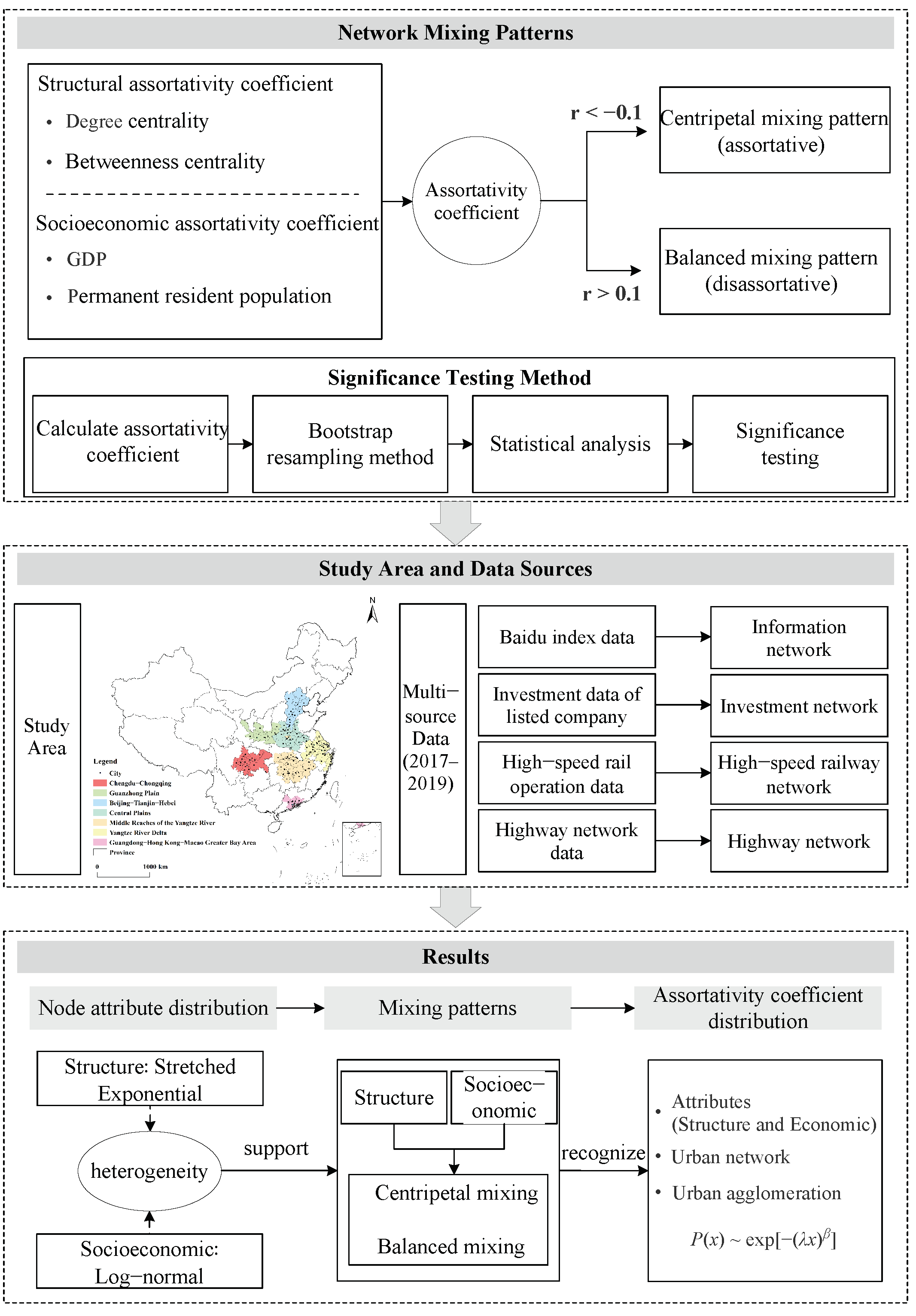

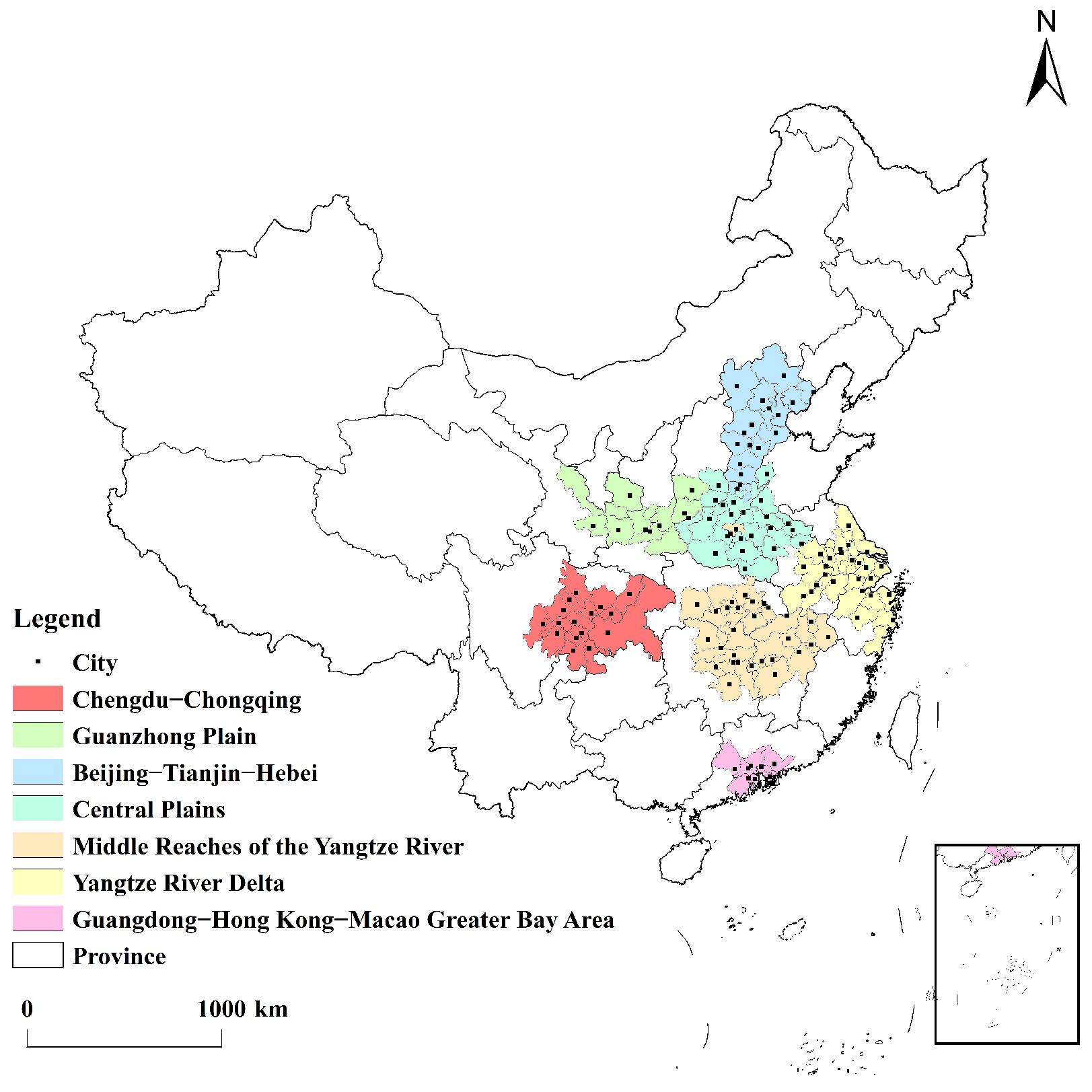
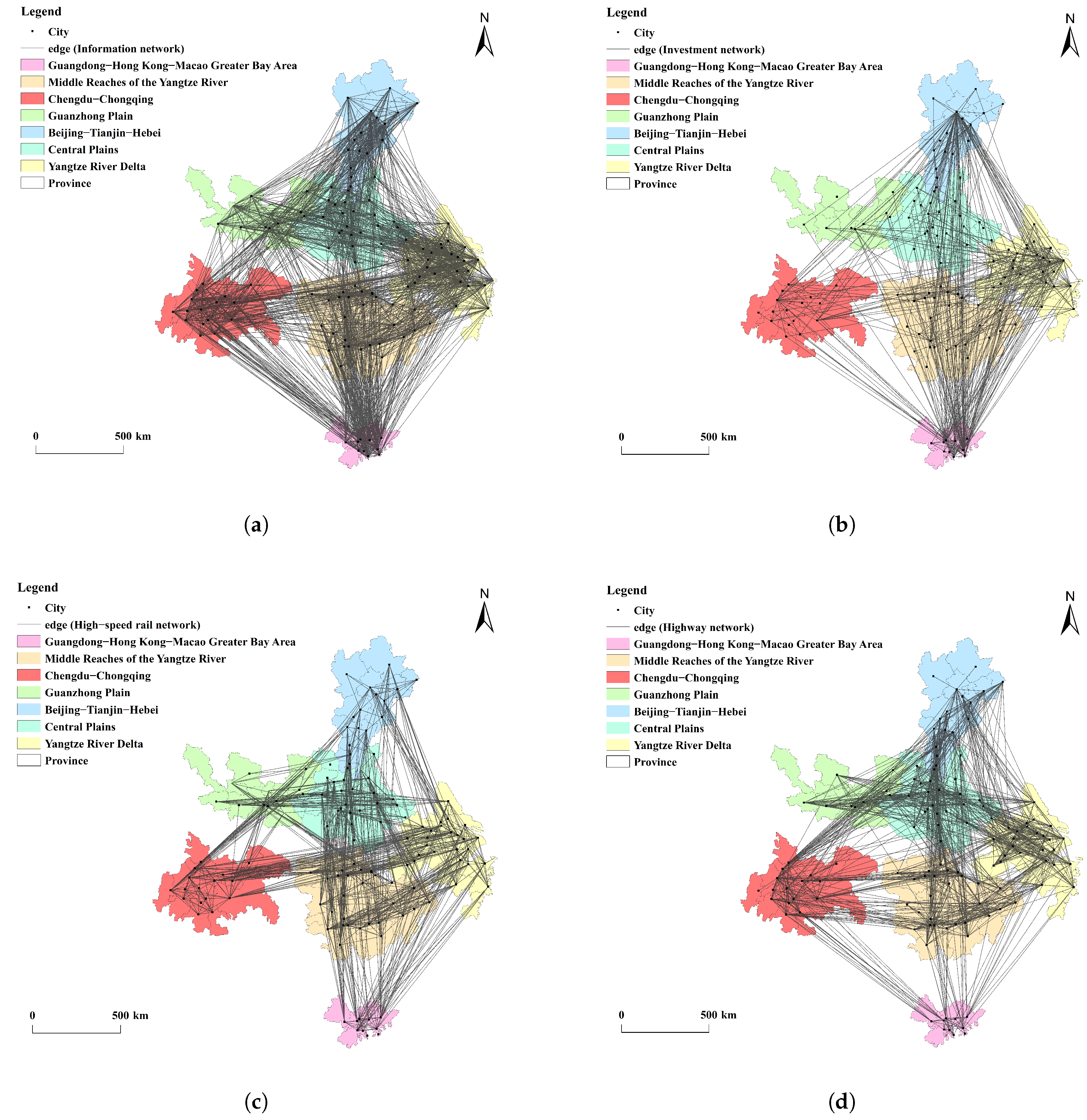
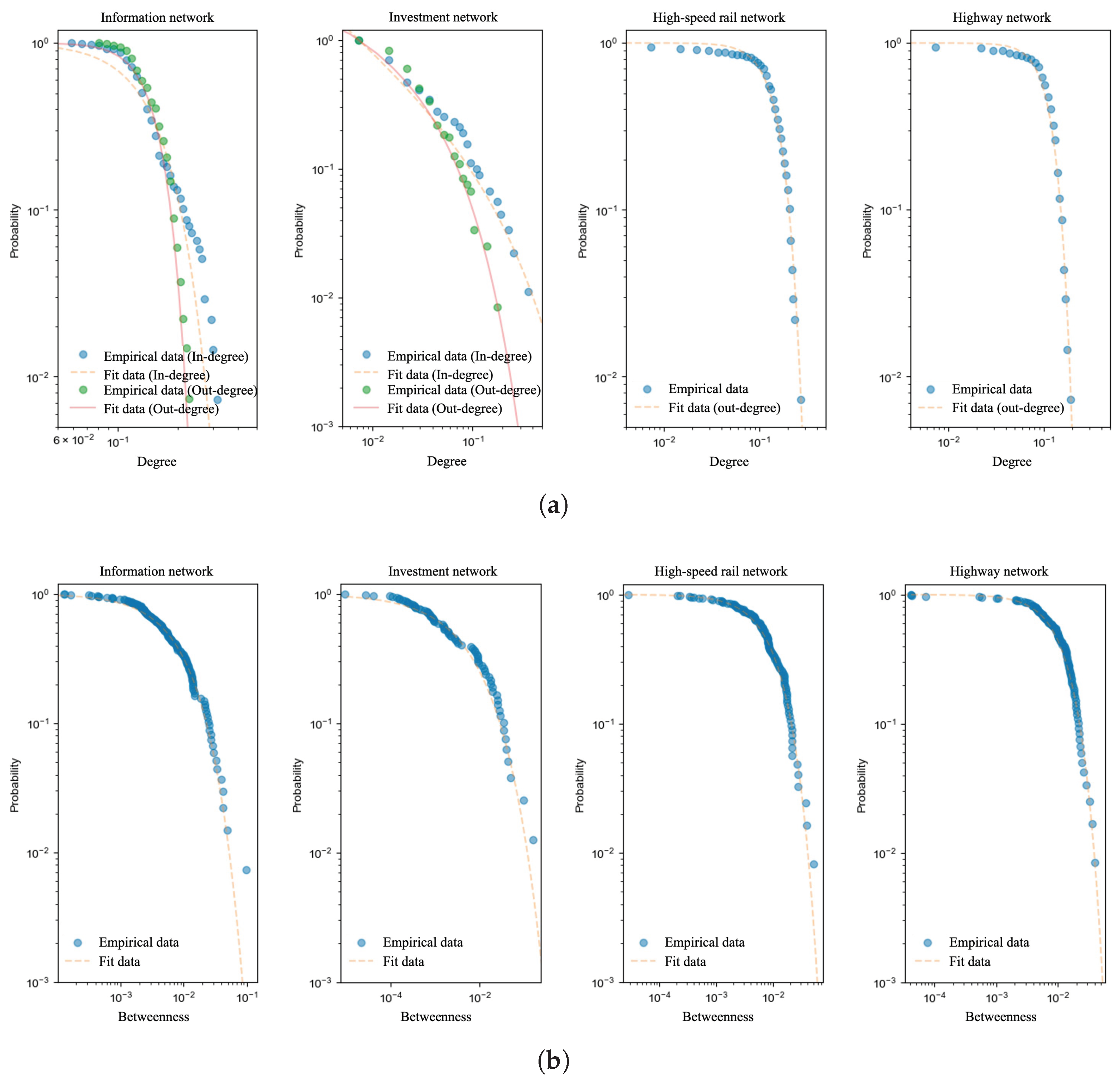
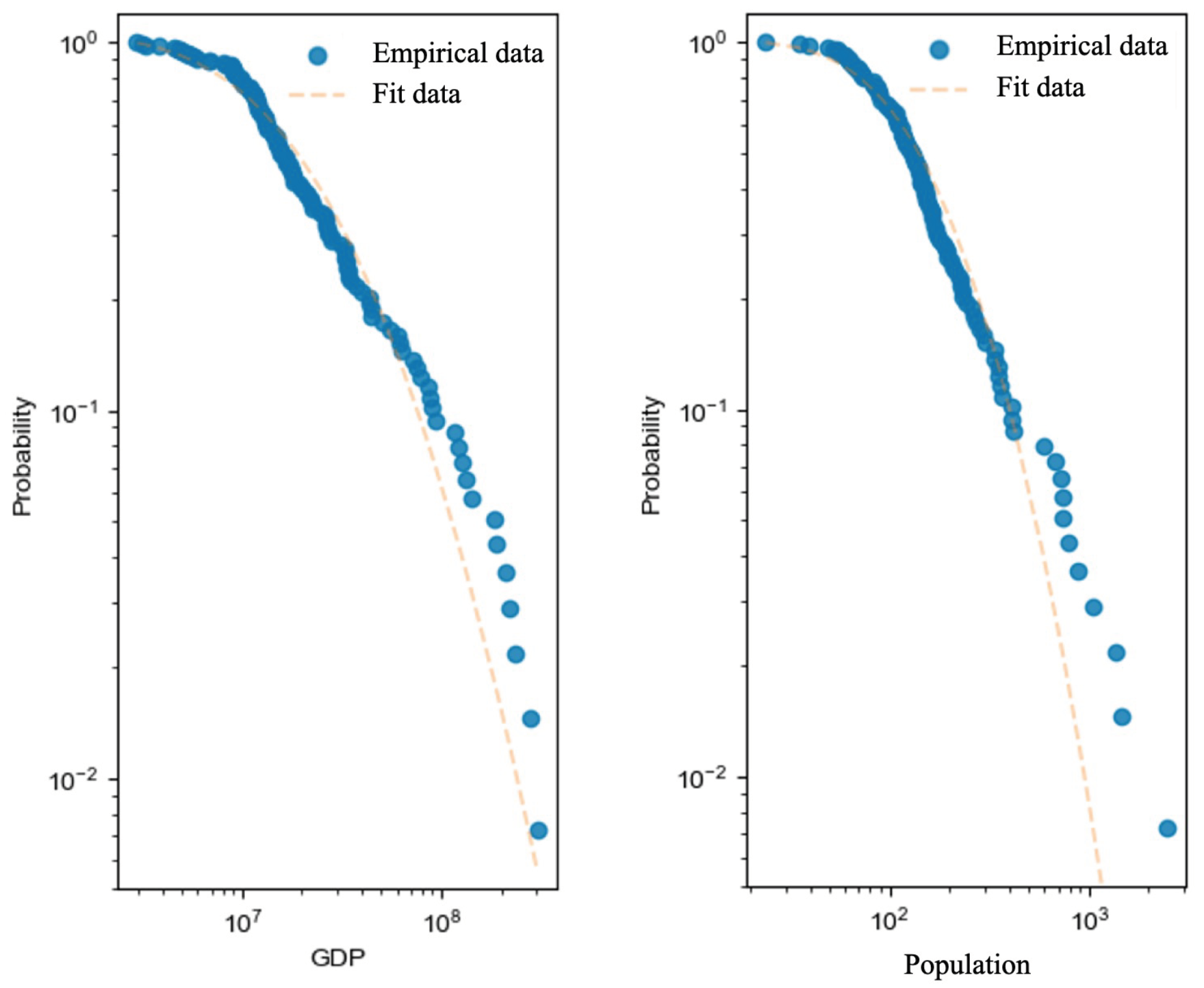
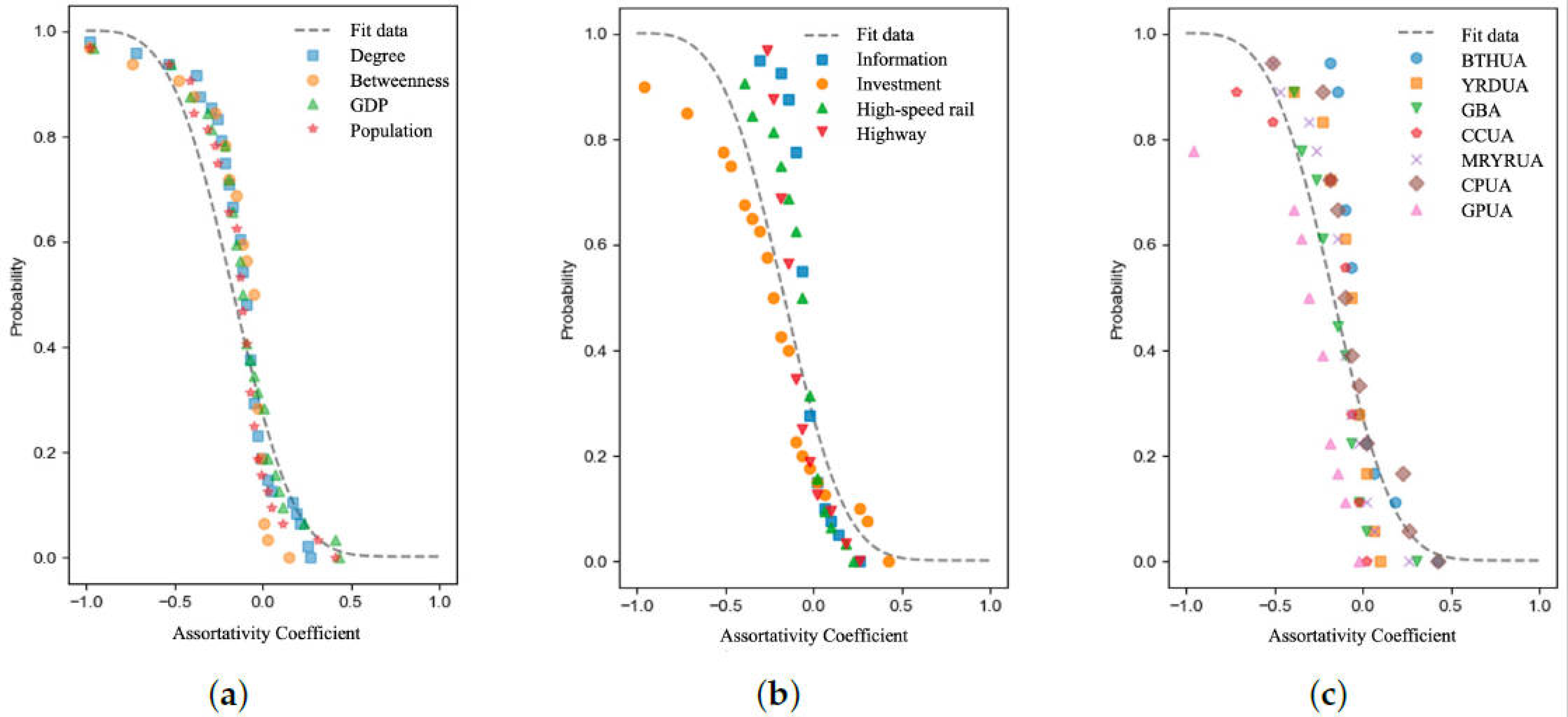
| Urban Agglomeration | Constituent Cities | Number of Cities | GDP (Billion Yuan) | Population (Million Person) | Area (km2) |
|---|---|---|---|---|---|
| Beijing–Tianjin–Hebei Urban Agglomeration (BTHUA) | Beijing, Tianjin, Baoding, Tangshan, Langfang, Shijiazhuang, Qinhuangdao, Handan, Xingtai, Zhangjiakou, Chengde, Cangzhou, Hengshui, Dingzhou, Xinji, Anyang | 16 | 867.05 | 108.96 | 218,000 |
| Yangtze River Delta Urban Agglomeration (YRDUA) | Shanghai, Nanjing, Wuxi, Changzhou, Suzhou, Nantong, Yancheng, Yangzhou, Zhenjiang, Taizhou, Hangzhou, Ningbo, Shaoxing, Wenzhou, Huzhou, Jiaxing, Jinhua, Zhoushan, Taizhou, Hefei, Wuhu, Ma’anshan, Tongling, Anqing, Xuancheng, Chizhou, Chuzhou | 27 | 1973.49 | 132.63 | 211,700 |
| Guangdong–Hong Kong–Macao Greater Bay Area (GBA) | Guangzhou, Shenzhen, Zhuhai, Foshan, Dongguan, Zhongshan, Jiangmen, Huizhou, Zhaoqing, Hong Kong, Macao | 11 | 869.00 | 37.77 | 55,900 |
| Chengdu–Chongqing Urban Agglomeration (CCUA) | Chengdu, Chongqing, Zigong, Luzhou, Deyang, Suining, Neijiang, Leshan, Nanchong, Meishan, Yibin, Guang’an, Ziyang, Mianyang, Dazhou, Ya’an | 16 | 650.60 | 101.11 | 185,000 |
| Middle Reaches of Yangtze River Urban Agglomeration (MRYRUA) | Wuhan, Huangshi, Ezhou, Huanggang, Xiaogan, Xianning, Xiantao, Qianjiang, Tianmen, Xiangyang, Yichang, Jingzhou, Jingmen, Changsha, Zhuzhou, Xiangtan, Yueyang, Yiyang, Changde, Hengyang, Loudi, Nanchang, Jiujiang, Jingdezhen, Yingtan, Xinyu, Yichun, Pingxiang, Shangrao, Fuzhou, Ji’an | 31 | 915.01 | 131.42 | 326,100 |
| Central Plains Urban Agglomeration (CPUA) | Zhengzhou, Luoyang, Kaifeng, Nanyang, Anyang, Shangqiu, Xinxiang, Pingdingshan, Xuchang, Jiaozuo, Zhoukou, Xinyang, Zhumadian, Hebi, Puyang, Luohe, Sanmenxia, Jiyuan, Changzhi, Jincheng, Yuncheng, Xingtai, Handan, Liaocheng, Heze, Suzhou, Huaibei, Bengbu, Fuyang, Bozhou | 30 | 785.19 | 190.26 | 287,000 |
| Guanzhong Plain Urban Agglomeration (GPUA) | Xi’an, Baoji, Xianyang, Tongchuan, Weinan, Shangluo, Yuncheng, Linfen, Tianshui, Pingliang, Qingyang | 11 | 216.09 | 44.85 | 107,100 |
| Type | Number of Nodes | Number of Edges | Average Degree | Density | Proportion of the Largest Connected Component | Average Path Length | Average Clustering Coefficient |
|---|---|---|---|---|---|---|---|
| Information | 137 | 2627 | 19.1752 | 0.1410 | 98.54% | 2.2720 | 0.5801 |
| Investment | 137 | 528 | 3.8540 | 0.0283 | 52.55% | 1.5795 | 0.1891 |
| High-speed rail | 137 | 1176 | 8.5839 | 0.1262 | 94.16% | 2.2614 | 0.5176 |
| Highway | 137 | 918 | 6.7007 | 0.0985 | 94.89% | 2.4361 | 0.5285 |
| Type | Degree Centrality | Betweenness Centrality |
|---|---|---|
| Information | 4.22 (Out-degree)/2.48 (In-degree) | 0.93 |
| Investment | 0.68 (Out-degree)/0.14 (In-degree) | 0.48 |
| High-speed rail | 2.63 | 1.05 |
| Highway | 3.08 | 1.27 |
| Type | Information | Investment | High-Speed Rail | Highway | ||
|---|---|---|---|---|---|---|
| In-Degree | Out-Degree | In-Degree | Out-Degree | |||
| Global | −0.0162 *** | −0.0774 *** | −0.2289 ** | −0.1993 *** | 0.1678 ** | 0.1761 *** |
| BTHUA | −0.0419 *** | −0.0593 *** | −0.1016 ** | −0.2174 *** | −0.1494 *** | −0.1384 * |
| YRDUA | 0.0284 *** | 0.0362 *** | −0.1317 *** | −0.2391 *** | −0.0437 *** | −0.1898 * |
| GBA | −0.0897 *** | −0.0805 *** | −0.3609 *** | −0.0434 *** | −0.3737 *** | −0.3056 *** |
| CCUA | −0.0664 *** | −0.0667 *** | −0.7356 *** | −0.1138 ** | −0.0589 *** | −0.1282 *** |
| MRYRUA | −0.0766 *** | −0.1110 *** | −0.5421 *** | −0.0195 | −0.0894 *** | 0.2436 *** |
| CPUA | 0.2528 *** | 0.0155 *** | 0.2334 ** | −0.2482 *** | 0.1968 *** | −0.095 *** |
| GPUA | −0.2064 *** | −0.1734 *** | −0.1217 | −0.9987 *** | −0.3773 *** | −0.2625 *** |
| Type | Information | Investment | High-Speed Rail | Highway |
|---|---|---|---|---|
| Global | −0.0458 *** | −0.2878 *** | −0.0092 * | −0.1178 *** |
| BTHUA | −0.0373 *** | −0.1197 *** | −0.0688 *** | 0.1482 *** |
| YRDUA | −0.0046 *** | −0.1295 *** | −0.0331 *** | −0.1932 *** |
| GBA | −0.0497 *** | −0.3968 *** | −0.2290 *** | −0.1553 *** |
| CCUA | −0.0184 *** | −0.7549 *** | −0.0250 * | −0.0547 *** |
| MRYRUA | −0.0240 *** | −0.4771 *** | 0.0216 | −0.0095 *** |
| CPUA | −0.0312 *** | −0.1055 | 0.0067 * | −0.1976 *** |
| GPUA | −0.0349 *** | −0.9985 *** | −0.0329 ** | −0.2302 *** |
| Type | Information | Investment | High-Speed Rail | Highway |
|---|---|---|---|---|
| Global | 0.2263 *** | −0.1197 *** | 0.0816 *** | 0.0699 *** |
| BTHUA | −0.0558 *** | 0.4047 *** | 0.0285 | −0.1053 *** |
| YRDUA | 0.0948 *** | −0.4190 *** | −0.0408 *** | 0.0174 *** |
| GBA | 0.0020 | −0.1596 *** | −0.1422 *** | −0. 1800 *** |
| CCUA | −0.0798 *** | −0.5329 *** | 0.0112 | −0.2056 *** |
| MRYRUA | −0.1537 *** | −0.3260 *** | −0.1191*** | −0.1057 *** |
| CPUA | −0.1035 *** | 0.4220 *** | −0.2192 *** | −0.1747 *** |
| GPUA | −0.3080 *** | −0.9712 *** | −0.4282 *** | −0.2039 *** |
| Type | Information | Investment | High-Speed Rail | Highway |
|---|---|---|---|---|
| Global | 0.1096 *** | 0.0390 *** | −0.0128 *** | −0.0593 *** |
| BTHUA | −0.0471 *** | 0.4141*** | 0.0119 | −0.1283 *** |
| YRDUA | −0.0453 *** | −0.4122 *** | −0.0882 *** | −0.0978 *** |
| GBA | −0.0614 *** | 0.3037 *** | −0.4196 *** | −0.2574 *** |
| CCUA | −0.0825 *** | −0.2090 *** | −0.0735 *** | −0.1402 *** |
| MRYRUA | −0.1418 *** | −0.2816 *** | −0.1464 *** | −0.1560 *** |
| CPUA | −0.1209 *** | −0.5358 *** | −0.1958 *** | −0.0915 *** |
| GPUA | −0.3280 *** | −0.9883 *** | −0.4102 *** | −0.1987 *** |
Disclaimer/Publisher’s Note: The statements, opinions and data contained in all publications are solely those of the individual author(s) and contributor(s) and not of MDPI and/or the editor(s). MDPI and/or the editor(s) disclaim responsibility for any injury to people or property resulting from any ideas, methods, instructions or products referred to in the content. |
© 2025 by the authors. Licensee MDPI, Basel, Switzerland. This article is an open access article distributed under the terms and conditions of the Creative Commons Attribution (CC BY) license (https://creativecommons.org/licenses/by/4.0/).
Share and Cite
Zhang, K.; Jia, L.; Xu, S. Recognizing Mixing Patterns of Urban Agglomeration Based on Complex Network Assortativity Coefficient: A Case Study in China. Appl. Sci. 2025, 15, 2024. https://doi.org/10.3390/app15042024
Zhang K, Jia L, Xu S. Recognizing Mixing Patterns of Urban Agglomeration Based on Complex Network Assortativity Coefficient: A Case Study in China. Applied Sciences. 2025; 15(4):2024. https://doi.org/10.3390/app15042024
Chicago/Turabian StyleZhang, Kaiqi, Lujin Jia, and Sheng Xu. 2025. "Recognizing Mixing Patterns of Urban Agglomeration Based on Complex Network Assortativity Coefficient: A Case Study in China" Applied Sciences 15, no. 4: 2024. https://doi.org/10.3390/app15042024
APA StyleZhang, K., Jia, L., & Xu, S. (2025). Recognizing Mixing Patterns of Urban Agglomeration Based on Complex Network Assortativity Coefficient: A Case Study in China. Applied Sciences, 15(4), 2024. https://doi.org/10.3390/app15042024







